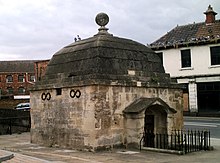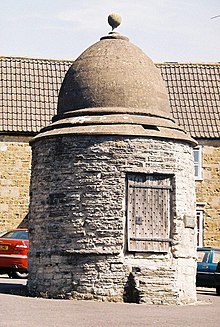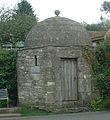Village lock-up


Village lock-ups are historic buildings that were used for the temporary detention of people in rural parts of England and Wales. They were often used for the confinement of drunks who were usually released the next day or to hold people being brought before the local magistrate. A typical village lock-up is a small structure with a single door and a narrow slit window or opening. Most lock-ups feature a dome or spire shaped roof and are commonly built from brick, large stones or timber.
The village lock-up is found in a variety of shapes often round or polygonal in plan, usually freestanding but some are attached to or incorporated in other buildings. Variations in design, materials and appearance occur although they were all built to perform the same function.
Nicknames
Village lock-ups have acquired a range of local nicknames including blind-house, bone-house, bridewell, cage, jug, kitty, lobby, guard-house, round-house, tower and watch-house.
Rise of the village lock-up

The majority of surviving village lock-ups date from the 18th and 19th centuries when rural communities struggled to police thefts, burglaries, shootings, drunkenness, the obstruction of watchmen and the stealing of livestock. During this period a number of lock-ups were built as a temporary place of detention for local rogues and miscreants until they could be removed to a town. Over time they became synonymous with drunkenness and many references to this coupling can be found in famous works of literature, including Barnaby Rudge (1841). by Charles Dickens, and The Water-Babies, A Fairy Tale for a Land Baby (1863). by Charles Kingsley, which contains the following line:
- Put him in the round house till he gets sober[1]

An 1830 description of a lock-up in Taunton describes "... a hole into which drunken and bleeding men were thrust and allowed to remain until the following day when the constable with his staff of office take the poor, crippled and dirty wretches before a magistrate, followed by half the boys and idle fellows of the town."[2]
Some lock-ups also had stocks, ducking stools, pillories, or pinfolds alongside them and the origins of the 18th century village lock-up evolved from much earlier examples of holding cells and devices.
The Oxford English Dictionary, for example, refers to a round-house as a place of detention for arrested persons and dates its first written usage to 1589.[3]
Decline and later uses

The village lock-up fell out of use when the County Police Act was introduced in 1839 and local police stations were built with their own holding facilities. The Act allowed Justices of the Peace to set up a paid police force in each county and made it compulsory for that force to be provided with proper police stations and secure cells. The village lock-up became a redundant edifice as a result and only a small fraction have survived the intervening century and a half.
During World War II many lock-ups were used by the Home Guard as sentry posts or places for storing arms.
In recent years a number of village lock-ups have been restored, and graded as listed buildings. Some are regarded as local heritage attractions while others remain in a ruinous state or have been converted into private buildings.
The official register of these structures and their locations, including those which have been lost, is held by the Village Lock-up Association (e-mail: plumridge@architect-uk.com).
Notable village lock-ups

The crest of Everton Football Club features Everton Lock-Up which still stands on Everton Brow, Liverpool.
D. H. Lawrence and his German-born wife Frieda had to report to the lock-up in Wirksworth during the First World War when they lived at Middleton-by-Wirksworth.
The roof of Castle Cary lock-up is reputed to have inspired the design of the modern British police helmet.
In 1281 a structure similar to a common village lock-up (the Tun) was erected in Cornhill, central London. It was a two-storey barrel shaped design and had a single cell on each floor.[4]
Surviving lock-up locations in England and Wales

(An asterisk is used to denote lock-ups that have been assimilated into other buildings such as a church or house.)
This section needs additional citations for verification. (February 2014) |
- Bedfordshire
Barton in the Clay, Clophill, Harrold, Silsoe
- Berkshire
- Buckinghamshire
Amersham, Great Missenden, Wendover*, West Wycombe
- Cambridgeshire
Anstey, Broughton, Burwell, Coveney, Eaton Socon, Fen Drayton, Fenstanton, Litlington, Needingworth, Parson Drove, Sawtry
- Cheshire
- Derbyshire
Alfreton, Ashbourne?, Church Gresley, Curbar, Cromford, Derwent Valley Mills*, Melbourne?, Sandiacre, Smisby, Swarkestone (Ruin?), Ticknall, Weston on Trent?, Wirksworth*
- Dorset
Swanage (a lock up in Lyme Regis is now a part of a building)
- Durham
Barnard Castle*, Staindrop*
- East Sussex
Pevensey
- Essex[6]

Bradwell on Sea, Braintree,[7] Canewdon, Great Bardfield, *Orsett, Steeple Bumpstead, Thaxted (in Guildhall), Tollesbury
- Gloucestershire

Bisley, Bibury, Cirencester, Filkins, Moreton in the Marsh, Stroud*, Thornbury, Westerleigh*
- Greater London
- Hampshire
- Herefordshire
Bridstow, Leintwardine*, Yarpole*
- Hertfordshire
Anstey, Ashwell, Barley, Buntingford, Shenley
- Kent
Dartford, Lenham, Wateringbury
- Lancashire
Bury, North Meols, Poulton le Fylde?, Prescot
- Leicestershire
Barrow-upon-Soar, Breedon-on-the-Hill, Castle Donington?, Packington, Worthington
- Lincolnshire
- Merseyside
- Norfolk
Docking, Great Yarmouth, Thetford?
- Northamptonshire
Weldon
- Northumberland
- Nottinghamshire
Edwinstowe?, Mansfield Woodhouse?, Tuxford
- Oxfordshire
Banbury*, Bicester*, Burford*, Stonesfield, Wheatley
- Somerset

Bathford, Buckland Dinham?, Castle Cary, Frome, Kelston Kilmersdon, Kingsbury Episcopi, Mells, Merriott, Monkton Combe, Nunney, Pensford, St Mary's Nether Stowey, Watchett, Wells*
- Staffordshire
Alton, Gnosall, Penkridge, Stafford
- Suffolk
Sproughton, Stoke by Nayland, Woolpit
- Surrey
- Wiltshire


Box, Bradford on Avon, Bromham, Chippenham, Devizes, Great Bedwyn, Heytesbury, Hilperton, Lacock, Luckington, Shrewton, Steeple Ashton, Trowbridge, Warminster
- Yorkshire
Addingham?, Illingworth, Heptonstall, Holmfirth, Hunmanby, Kirkheaton, Luddenhan, Nether Poppleton?, North Stainley?, Oswaldkirk, Rastrick, Rotherham, Seamer, Snaith, Topcliffe?, Wath-upon-Dearne
- Clwyd
- Flintshire
Bagillt?, Hawarden
- Gwynedd
Barmouth, Clynnog Fawr
Gallery
-
Deeping St James lock-up
-
Digby lock-up
-
Everton lock-up
-
Fenstanton lock-up clock tower
-
Monkton Combe lock-up
-
Packington lock-up
-
Pensford lock-up
-
Watchman's hut and lock-up, Petersham, London, erected 1787.
-
Snaith Town lock-up
-
Steeple Ashton lock-up
-
Warminster lock-up
-
Wavertree lock up
See also
References
- ^ Kingsley, Charles (1863). The Water-Babies, A Fairy Tale for a Land Baby.
- ^ Worthington Parish Council, The Round House Worthington, North West Leicestershire District Council. (pamphlet).
{{citation}}: CS1 maint: postscript (link) - ^ Oxford English Dictionary.
- ^ "Cornhill, Gracechurch Street, and Fenchurch Street'". Old and New London. 1878. pp. 170–183.
- ^ Historic England. "Lock Up on the end of the barn at Weldon House (Grade II) (1130532)". National Heritage List for England. Retrieved 8 March 2015.
- ^ Bettley, James (2007). Essex (Buildings of England series). New Haven and London: Yale UP. ISBN 978-0300116144.
- ^ Historic England. "The Cage or Lock Up (Grade II) (1338314)". National Heritage List for England. Retrieved 8 December 2015.
- ^ Fison, Vanessa (2009). The Matchless Vale: the story of Ham and Petersham and their people. Ham and Petersham Association. pp. 104–105. ISBN 978-0-9563244-0-5.
- Plumridge, Andrew. The National Directory of Village Lock-Ups, Stocks, Pillories, Gallows, Gibbets, Pounds and Pinfolds, and Other Pre-Police Force Punishment and Detention Devices.
- Shipman, Juliet. The Bisley Lock-up: A story of crime and punishment.




















